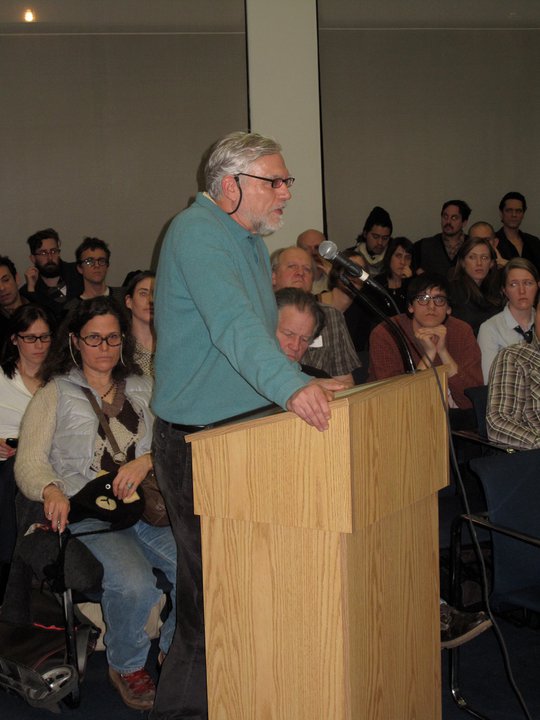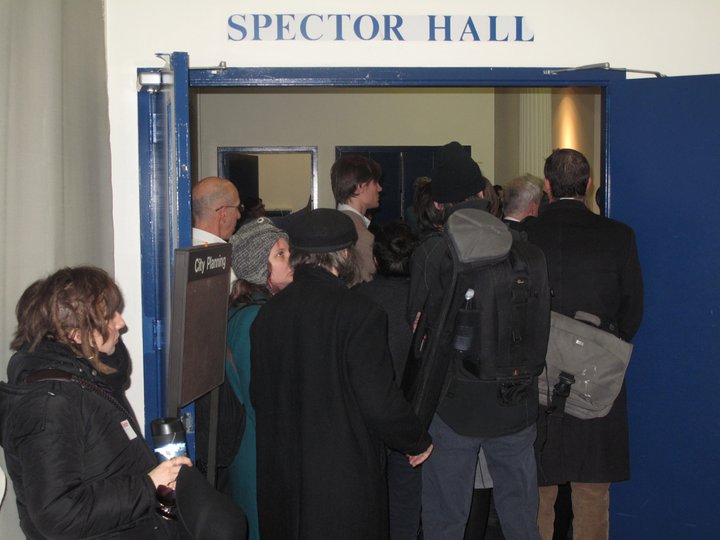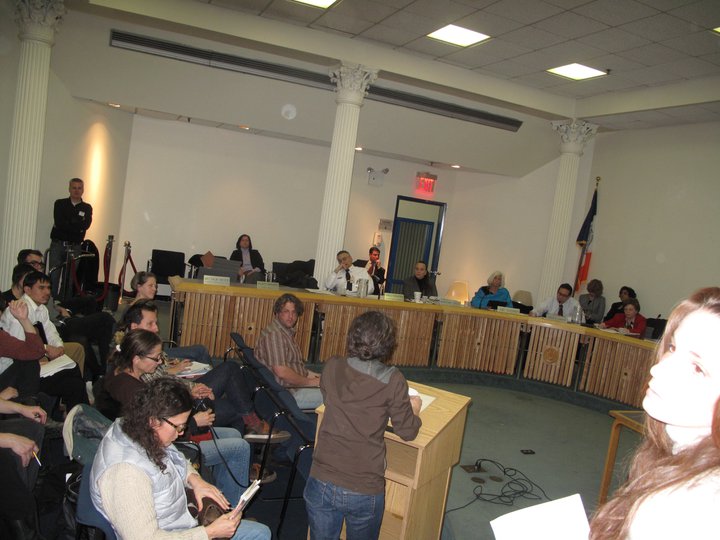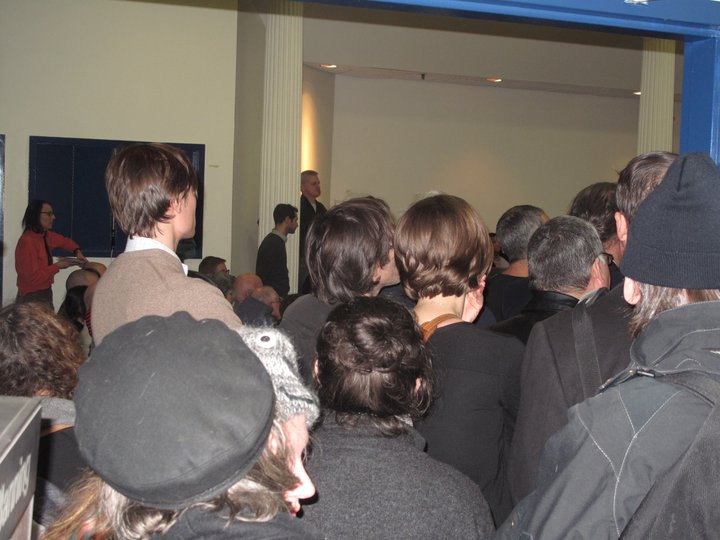
Jim Fleming of the book press Autonomedia, and longtime resident on the storied South 11th Street in Williamsburg, testifies at last night's Loft Board hearing.
At the conclusion of last night’s special hearing in Manhattan on a proposed amendment to the Loft Law that would make it more difficult for many loft dwelling artists to qualify for protection under the law, Loft Board member Chuck DeLaney thanked the people who packed the chamber, the great majority of whom were loft dwellers who’d come to testify against the proposed rule.
“You were very effective today in making clear to the Board how important this is to you,” said DeLaney. “The Loft Board is going to defer this discussion and table voting. We are going to extend the comment period and possibly hold another hearing.”
So, it was a victory for loft dwellers in Brooklyn, for the moment. But DeLaney then wrapped up the hearing with an appeal to those present:
“We on the Loft Board are in a difficult position, because this issue concerns zoning, and zoning was designed to exclude certain situations. What we really need here are creative solutions. I really hope that some of you will put together some creative ideas.”
Well okay, here is a creative idea for how to approach this controversial add-on to the Loft Law. Start by throwing out the old script. Start by purging this discourse once and for all of the malign insinuation that artists who live and work in lofts are “incompatible” with a manufacturing sector with which they have existed in harmony for three decades.
Start with the premise that artists, and loft-dwelling artists in particular, far from being incompatible with industry, have been the pioneers of a new industrial economy in Brooklyn. And moreover that loft-dwelling artists are themselves manufacturers, albeit of a new kind, of a new “creative economy” that is the envy of many an American city today. And start with the assumption that this is a development that should be emulated and leveraged on every level of city policy, and not alienated from city policy.

Let us start by owning up to the fact that it is loft-dwelling artists who in the 1980s brought many of these industrial neighborhoods back from a very low point in their histories. They started woodworking shops, welding shops, design firms, art galleries, publishing houses, food and fashion companies, and a creative culture that transformed one of the most blighted neighborhoods in the city into one of the most desirable neighborhoods in the world. And all of this began, moreover, during the recession of the late 80s and early 90s, and fifteen years later steamed through the greatest economic downturn the world has seen in 80 years.
Let us dispense as well with platitudes such as those advanced by Councilwoman Diana Reyna at this hearing, that artists “displace” or “undermine” industry. In April last year Reyna supported a proposal to convert one of Brooklyn’s mightiest industrial landmarks, the Domino Sugar Factory, into one of Brooklyn’s tallest condominium towers. This she did on the grounds of an unwritten “promise” that the towers would include low-income housing. Well, last night Reyna was suddenly an advocate of “industrial retention.”
To be fair, Reyna wants, on the one hand, affordable housing for her constituency, and, on the other hand, she wants “walk to work” jobs in the relatively high-paying manufacturing sector. But the councilwoman’s pursuit of these goals has been self-defeating on both counts. A few hundred subsidized housing units at the Domino site remain a pie in the sky and, if they ever materialize, a drop in the bucket. And to characterize industrial retention in East Williamsburg as a matter of holding artists at bay (rather than a matter of people on the ground actually starting industries) is a negative polemic that fails to recognize a potential ally of industry in this area — artists!
What seems to be lost on Reyna is that for 30 years loft-dwelling artists in Williamsburg, Greenpoint, and Bushwick have created “housing” for themselves out of nothing, and with no legal or political protection of any kind. And what seems to be lost on Reyna is that for 30 years loft-dwelling artists in North Brooklyn have put in place a new economy of manufacturing and artisanship that benefits the whole area and should be integrated into the industrial and business scheme of North Brooklyn, not alienated from that scheme.

The controversial language in the proposed Rule 2-08 of the Loft Law states merely that the Loft Board must “ensure greater protection to the residential tenants by determining if buildings contain commercial, manufacturing or industrial uses which would be incompatible to residential use.”
These seemingly innocuous words have been enough to start a political bush fire in North Brooklyn. Loft advocates say it has nothing to do with “protecting” live-work tenants, but rather that the proposed rule gives landlords more latitude to stall Loft Law applications by artists, and even to evict artists, only to rent again to anyone who will pay a whole lot more for the loft. And in a year or two, the landlord might suddenly find the new tenant “incompatible” in some way, and do the whole thing again. The East Williamsburg-Bushwick Loft Tenants Association says this rule could put the brakes on 30 percent or more of applications for protection under the Loft Law.
As Chuck Delaney said, the proposed rule is about exclusion. It flows from “criteria” set out in the city’s Zoning Resolution. It should flow from the spirit of the Loft Law, not from the letter of municipal code. The rule is therefore somewhat disingenuous, and it reads like a primer on how to trump the Law on technicalities. We know the rule is not being pushed by Bloomberg and Reyna and other politicians out of any concern for the “greater protection” of loft dwellers, but most likely out of a concern over the greater political power these loft dwellers have realized during the 30-year history of this legislation.
A creative solution here would be to rewrite the rule in language that does not tacitly concede to the old saw of loft dwellers as a temporary fix for the real estate industry. Why, for example, if there is a problem with “compatibility” regarding industry, does the rule automatically disqualify the loft dweller. We know that in the real world there have almost never been problems between industry and artists. With this rule, there is now an incentive to create them.

The tenor of Rule 2-08 need not be on treating loft dwellers and commercial tenants as separate classes where it concerns the physical conditions in the building. These conditions can be aligned and addressed in a uniform way that assumes the viability of both loft dwelling and commercial use in the same place at the same time. That assumption, after all, is the very basis of the Loft Law, and its viability has been born out over three decades with overwhelmingly positive results. Rules and applications of the Loft Law that assume and seek out a harmonious outcome of industry and loft dwelling, could steer this law and its underlying doctrine to an economic renaissance the likes of which this city has never seen.
Leave a Reply